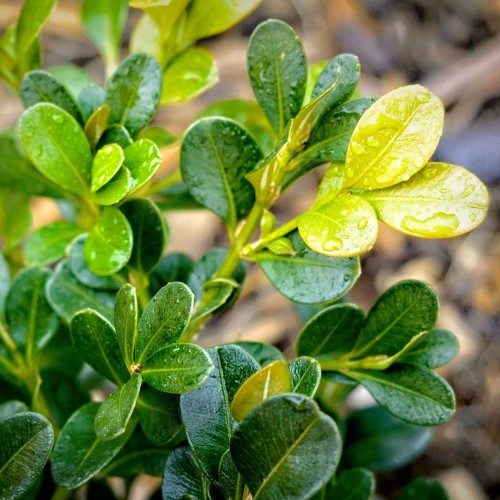
boxwood
Buxus microphylla
Also Known As - Korean boxwoodCycle:
Perennial
Watering:
Average
Hardiness Zone:
6 - 9
Flowers:
Flowers In Spring
Sun:
part sun/part shade,full sun
Soil:
Well-drained
Fruits:
Fruits In Summer Ready In Winter
Leaf:
Yes
Growth Rate:
High
Maintenance:
Moderate
Drought Tolerant:
Yes
Care Level:
Medium
watering
For best results, boxwood should be watered about once per week. The amount will depend on the particular boxwood, soil type, climate, and other factors. Generally, the boxwood should get enough water so that the topsoil feels moist but not soggy. If the soil dries out completely, it is important to water deeply to ensure the entire boxwood root system is hydrated. In hot and dry climates, additional watering may be necessary.
sunlight
Boxwood is a popular ornamental evergreen shrub reachable in a variety of sizes and shapes. Boxwood needs full sun to partial shade to thrive best, especially if planting in a warmer climate. In the winter months, boxwood needs about 4-5 hours of direct sunlight for optimal growth. In the summer months, they can tolerate a little more sun but should not be placed in full, direct sun for more than 6 hours per day.
pruning
Boxwood (Buxus microphylla) should be pruned in spring and autumn. During the spring pruning, remove dead, dying, and crossing branches in order to open up the canopy and stimulate new growth. In autumn, prune lightly, focusing only on shaping and thinning out crowded areas. Prune no more than 1/3 of the total volume of the plant when pruning.
Season
Hardiness Map
FAQ
Is Boxwood a popular landscape plant?
Yes, Boxwood is a popular landscape plant, due to its versatility in design, hardiness in cold temperatures, attractive foliage and its ability to be pruned into a variety of shapes. It makes an attractive year-round hedge, foundation plant or edging and, if left unpruned, can be grown as a small tree or shrub. Boxwoods can be planted either in the sun or partial shade and are a great addition to gardens of any size.
Are Boxwoods evergreen?
Yes, boxwoods are evergreen. They have deep green foliage and remain an attractive evergreen tree year-round, allowing for a versatile way to add color and structure to outdoor spaces. Boxwoods are also extremely easy to grow, making them a great choice for novice gardeners. Additionally, boxwoods are relatively low maintenance and can handle some light pruning if needed.
Can Boxwoods be trimmed into shapes?
Yes, boxwoods can be trimmed into shapes. With regular maintenance and occasional pruning, they can be cut and shaped into hedges, topiary, round forms and other creative patterns. Pruning them regularly also ensures that they remain healthy and look their best. It is important to trim them with the right tools and techniques in order to keep them healthy, while also achieving the desired shape.
Could Boxwoods be used as a hedge plant?
Yes, boxwoods can be used as a hedge plant. They are low-maintenance, evergreen shrubs that can be trimmed to create uniform hedges or shaped into topiary. Boxwoods are also resistant to disease and can tolerate both full sun and partial shade. They are ideal for small to medium hedges and make an attractive backdrop for annual and perennial flowers.
Should Boxwoods be planted in full sun or shade?
It depends on the variety of boxwood you have. Some varieties, such as English boxwood, are best planted in full sun for optimal growth and form. However, other varieties such as American and Korean boxwood do better in partial shade due to the more intense heat of full sun. In areas with long, hot summers and mild winters, provide some shade protection to prevent over-heating and drying out, especially during the hottest times of day.
